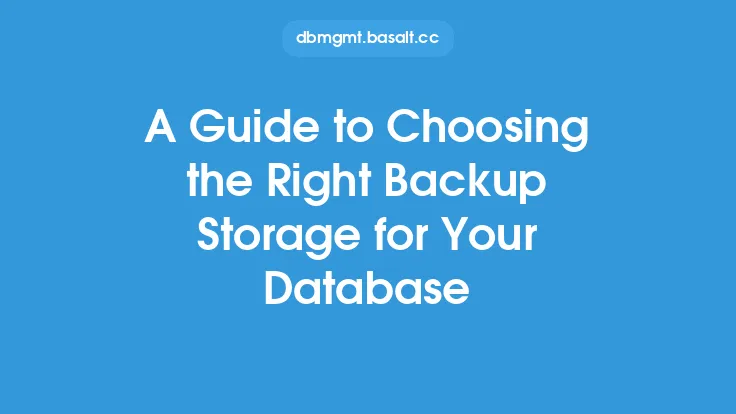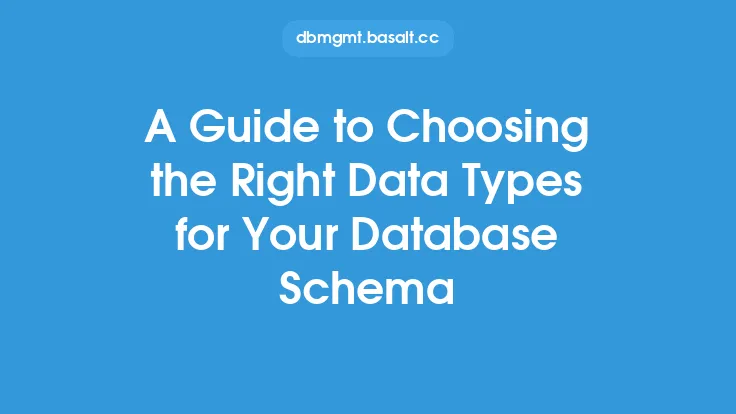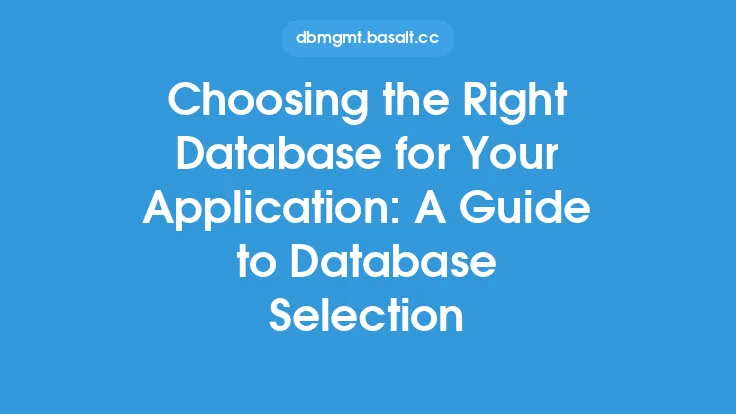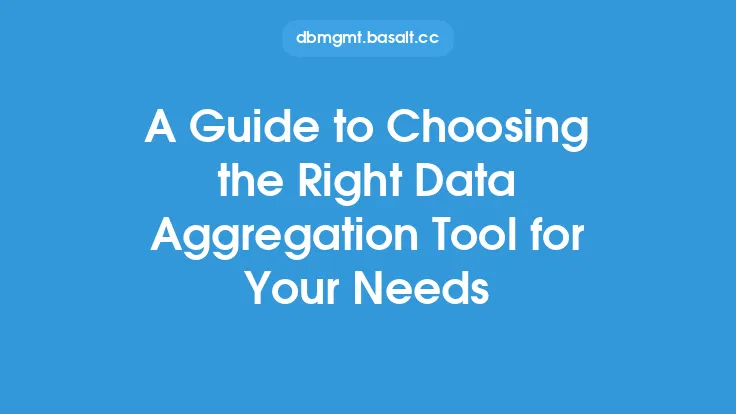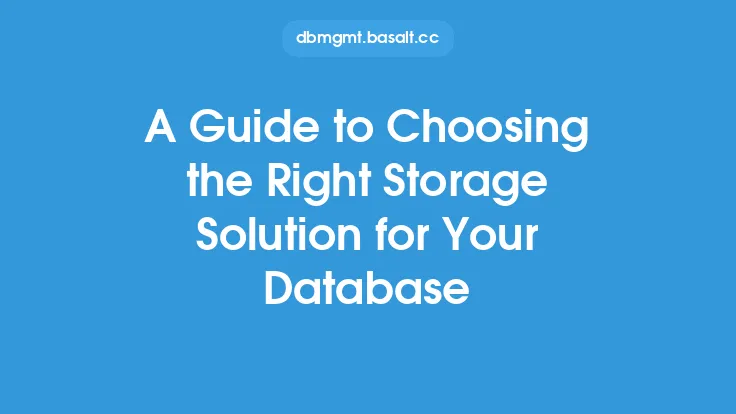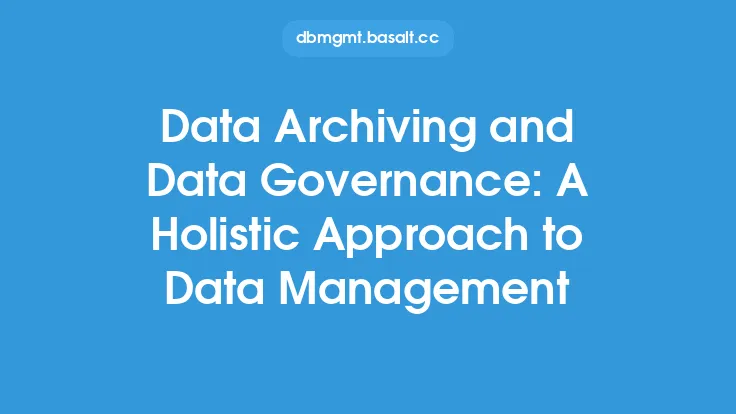Data archiving is a critical process in database management that involves storing and preserving data for long-term retention, while also ensuring its integrity, accessibility, and security. With the exponential growth of data, organizations are faced with the challenge of managing and storing large volumes of data, making data archiving a crucial aspect of database management. In this article, we will delve into the various data archiving methods, their advantages, and disadvantages, to help organizations choose the right approach for their specific needs.
Introduction to Data Archiving Methods
Data archiving methods can be broadly categorized into two main types: online archiving and offline archiving. Online archiving involves storing data on disk or tape, while offline archiving involves storing data on removable media such as CDs, DVDs, or external hard drives. Each method has its own set of advantages and disadvantages, and the choice of method depends on the organization's specific needs and requirements. Online archiving provides faster access to data, but it can be more expensive and requires more maintenance. Offline archiving, on the other hand, is more cost-effective, but it can be slower and more prone to data loss.
Disk-Based Archiving
Disk-based archiving involves storing data on disk, which provides fast access to data and is ideal for organizations that require frequent access to their archived data. Disk-based archiving can be further divided into two sub-categories: direct-attached storage (DAS) and network-attached storage (NAS). DAS involves connecting storage devices directly to a server, while NAS involves connecting storage devices to a network. Disk-based archiving provides high performance, scalability, and reliability, making it a popular choice for organizations that require fast access to their data.
Tape-Based Archiving
Tape-based archiving involves storing data on tape, which is a cost-effective and reliable method for long-term data retention. Tape-based archiving is ideal for organizations that require low-cost, high-capacity storage for infrequently accessed data. Tape-based archiving can be further divided into two sub-categories: linear tape-open (LTO) and advanced intelligent tape (AIT). LTO is a popular choice for tape-based archiving, as it provides high capacity, fast data transfer rates, and compatibility with a wide range of devices. AIT, on the other hand, provides high capacity, fast data transfer rates, and advanced features such as data compression and encryption.
Cloud-Based Archiving
Cloud-based archiving involves storing data in the cloud, which provides a scalable, on-demand, and cost-effective method for data archiving. Cloud-based archiving is ideal for organizations that require flexibility, scalability, and low upfront costs. Cloud-based archiving can be further divided into two sub-categories: public cloud and private cloud. Public cloud involves storing data in a shared, multi-tenant environment, while private cloud involves storing data in a dedicated, single-tenant environment. Cloud-based archiving provides high scalability, flexibility, and reliability, making it a popular choice for organizations that require a flexible and cost-effective data archiving solution.
Hierarchical Storage Management (HSM)
Hierarchical storage management (HSM) is a data archiving method that involves automatically moving data between different storage tiers based on its frequency of access. HSM is ideal for organizations that require a flexible and dynamic data archiving solution. HSM can be further divided into two sub-categories: policy-based HSM and rules-based HSM. Policy-based HSM involves defining policies for data movement based on its frequency of access, while rules-based HSM involves defining rules for data movement based on its metadata. HSM provides high flexibility, scalability, and reliability, making it a popular choice for organizations that require a dynamic and flexible data archiving solution.
Data Archiving Software
Data archiving software is a critical component of any data archiving solution, as it provides the necessary tools and features for managing and preserving data. Data archiving software can be further divided into two sub-categories: proprietary software and open-source software. Proprietary software involves using commercial software products, while open-source software involves using free and open-source software products. Data archiving software provides high functionality, flexibility, and reliability, making it a critical component of any data archiving solution.
Considerations for Choosing a Data Archiving Method
When choosing a data archiving method, organizations should consider several factors, including data volume, data type, data retention period, and data accessibility requirements. Organizations should also consider the cost, scalability, and reliability of the data archiving method, as well as its compatibility with existing systems and infrastructure. Additionally, organizations should consider the security and compliance requirements of their data, as well as the need for data encryption, compression, and deduplication. By considering these factors, organizations can choose the right data archiving method for their specific needs and requirements.
Best Practices for Implementing a Data Archiving Method
When implementing a data archiving method, organizations should follow best practices to ensure the integrity, accessibility, and security of their data. Organizations should define clear policies and procedures for data archiving, including data retention periods, data accessibility requirements, and data security requirements. Organizations should also ensure that their data archiving method is scalable, reliable, and compatible with existing systems and infrastructure. Additionally, organizations should ensure that their data archiving method provides high functionality, flexibility, and reliability, and that it meets the necessary security and compliance requirements. By following these best practices, organizations can ensure the success of their data archiving method and the integrity, accessibility, and security of their data.
Conclusion
In conclusion, data archiving is a critical process in database management that involves storing and preserving data for long-term retention, while also ensuring its integrity, accessibility, and security. Organizations have several data archiving methods to choose from, including online archiving, offline archiving, disk-based archiving, tape-based archiving, cloud-based archiving, and hierarchical storage management. When choosing a data archiving method, organizations should consider several factors, including data volume, data type, data retention period, and data accessibility requirements. By following best practices and considering these factors, organizations can choose the right data archiving method for their specific needs and requirements, and ensure the integrity, accessibility, and security of their data.
